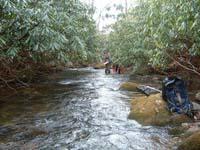Macroinvertebrate Bioassessment Standard Operating Procedures (SOP) and Metric Spreadsheets
 Guidelines
for Using Third Party Biological Data For 305(b)/303(d) Purposes (Revised April 2019)
Guidelines
for Using Third Party Biological Data For 305(b)/303(d) Purposes (Revised April 2019)
Georgia EPD Macroinvertebrate Biological Assessment Workshop for Wadeable Streams Information
Starting in the mid 1980s, biologists for the Watershed Planning and Monitoring Program (WPMP) of EPD's Watershed Protection Branch began adopting U.S. Environmental Protection Agency (USEPA) protocols for watershed assessments and subsequently developed standard operating procedures for macroinvertebrate assessments of streams. From 1998 to 2001, USEPA, with assistance from the Natural Resources Conservation Service (NRCS), refined the national level III ecoregions. Within each ecoregion, USEPA and NRCS also refined and delineated more localized level IV ecoregions, or subecoregions.
In the early 2000s, Columbus State University (CSU) was contracted by EPD's Watershed Protection Branch to develop macroinvertebrate metric indices that would take into account the ecological differences of Georgia’s subecoregions. Using land-use GIS data, CSU delineated watersheds across all gradients of human disturbance (from least impacted, or reference, to the most heavily impacted) for second- to fourth-order streams statewide. Streams from across the gradient of human disturbance were sampled and analyzed from each of Georgia’s subecoregions. Using the sampling data CSU developed, 24 discrete metric indices, including one tidal index. To go along with these indices, a standardized numerical scoring system was developed, which can then be translated into a five-step descriptive classification system that ranks a stream’s health as very good, good, fair, poor or very poor.
Currently, biologists from the Ambient Monitoring Unit (AMU) in WPMP are working to determine criteria for listing streams on the 303(d) list for impaired water bodies based on macroinvertebrate biology data. Each year, AMU collects new site data to help increase the ability in which the classification system is able to discriminate all environmental gradients. AMU also periodically returns to randomly selected sample sites to gather more data for environmental gradient discrimination and to monitor possible changes due to human disturbance or restoration efforts.

Future projects include evaluating possible differences between drought and non-drought conditions and differences between clear-water and black-water streams that occur in the same subecoregion. Other future projects include developing additional biological criteria and methods using periphyton (attached algae) as indicators and coordinating AMU data with Georgia Wildlife Resources Division (WRD) fish data to get a more complete picture of biological integrity and ecological function of Georgia’s streams.
 Macroinvertebrate
Biological Assessment of Wadeable Streams in Georgia - Standard Operating Procedures (SOP) [May 2007]
Macroinvertebrate
Biological Assessment of Wadeable Streams in Georgia - Standard Operating Procedures (SOP) [May 2007]
Revised
EPD Macroinvertebrate SOP Field Sheets [Aug 31, 2016]
Watershed
Assessment Macroinvertebrate SOP Field and Laboratory Sheets [Aug 31, 2016]
SOP Supporting Documents:
-
Taxonomic References [May 2012]
-
GAEPD Taxa List with Functional Feeding Group (FFG), Habit, and Tolerance Values (MS Excel) [May 2012]
-
GAEPD Macroinvertebrate Metric Calculation Guidelines [May 2007]
-
GAEPD Protocols for Determining Tolerance Values/Habit/FFG [May 2007]
-
Guidelines for Using Old Macroinvertebrate Data with the New Metrics [May 2007]
-
Map of Macroinvertebrate_Level_III_&_Level_IV_Ecoregions of_Georgia [May 2007]
-
Level III & Level IV Ecoregions of Georgia GIS Shapefiles (ZIP) [Feb 2012]
-
Level III & Level IV Ecoregions of Georgia Google Earth KMZ (ZIP) [Feb 2012]
Ecoregion Metric Spreadsheets
The MS Excel spreadsheets and associated documents are compressed into a separate ZIP file for each subecoregion.
Ecoregion 45-Piedmont
45a-Southern
Inner Piedmont [05/2008]
45b-Southern
Outer Piedmont [11/2007]
45c-Carolina Slate Belt *Coming Soon*
45d-Talladega
Upland [11/2007]
45h-Pine Mountain Ridges *Coming Soon*
Ecoregion 65-Southeastern Plains
65d-Southern
Hilly Gulf Coastal Plain [11/2007]
65k-Coastal
Plain Red Uplands [11/2007]
65l-Atlantic
Southern Loam Plains [12/2011]
65o-Tallahassee Hills/Valdosta Limesink *Coming Soon*
Ecoregion 66-Blue Ridge
66d-Southern
Crystalline Ridges & Mountains [11/2007]
66g-Southern
Metasedimentary Mountains [11/2007]
Ecoregion 67-Ridge & Valley
67f&i-Southern
Limestone/Dolomite Valleys & Low Rolling Hills and Southern Dissected Ridges & Knobs [06/2018]
*New Update*
67g-Southern
Shale Valleys [11/2007]
67h-Southern Sandstone Ridges *Coming Soon*
Ecoregion 68-Southwestern Appalachians
68c&d-Plateau Escarpment and Southern Table Plateaus *Coming Soon*
Ecoregion 75-Southern Coastal Plain
75e-Okefenokee
Plains [12/2011]
75f-Sea
Island Flatwoods (non-tidal) [12/2011]
75h-Bacon Terraces *Coming Soon*
75j-Sea
Islands/Coastal Marsh (non-tidal) [11/2007]
For questions about the macroinvertebrate SOP, please contact Michele Brossett, 404-651-8451, [email protected] or Cody Jones, 404-651-8452, [email protected].